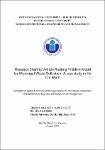| dc.description.abstract | Underdeveloped and developing countries face notable challenges in municipal solid
waste (MSW) collection and transportation, as the volume of waste generated rapidly
increases, while facilities and budgets remain limited. Utilizing current resources
becomes crucial for cost-saving in waste management. However, there is a scarcity
of studies on resource sharing in municipal solid waste collection and transportation
systems (MSCTS), considering all relevant real-life factors. This study proposes a
vehicle routing problem (VRP) model that enables sharing depots, transfer stations,
heterogeneous vehicle fleets, split delivery, multi-trips, and time windows to
minimize the total traveling distance.
Nearest Neighbor Search (NNS) is utilized for tackling large-scale problems, while a
precise technique referred to as the Exact Method (EM) is applied for problems of
medium scale. These initial solutions are then refined using Heap's algorithm (HA)
and the Replacement algorithm (RA) to yield improved results. Comparative
outcomes show that the EHR approach (EM+HA+RA) achieves a routing gap of 1.9%
when compared to the optimal solution obtained from the CPLEX solver. This
outperforms the NHR approach (NNS+HA+RA), which exhibits a larger gap of 9.2%.
Notably, the NHR approach also outperforms the Simulated Annealing method,
achieving a routing gap of 1.5% in terms of objective values, and demonstrating a
computational time that is 408% faster.
Furthermore, the suggested VRP (Vehicle Routing Problem) framework is put into
practice for managing the collection of solid waste (SW) in three adjacent districts of
Ho Chi Minh City. Employing this model leads to a substantial decrease of 39.6% in
the overall travel distance. In addition, there is a reduction of 14 trips and the use of
13 fewer vehicles within a single day, highlighting better resource utilization in waste
collection activities. These results emphasize the advantageous outcomes of sharing
resources, which not only cuts down transportation expenses but also enhances the
efficiency of resource allocation in waste management systems. | en_US |


